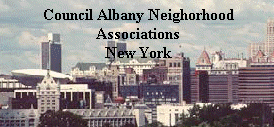A few years ago, architect
Michael Sorkin edited a collection of articles for his book,
"Variations on a Theme Park: The New American City and the
End of Public Space." They dealt with what Sorkin saw as a
"new world order bent on a single citizenship of
consumption" and its effect of "sacrificing the idea
of the city as a site of community and human connection."
Sadly, a new chapter in this trend may take place in Pine
Hills, Albany's residential heart. The landmark art deco Madison
Theatre is threatened by the CVS juggernaut, which wants to
build a 13,000-square-foot drugstore with a drive-through and
ample parking, paving over paradise. Visit the new CVS on
Congress Street in Saratoga Springs to see what can be in store
for Albany -- what writer Jim Kunstler calls "another
amazing architectural botch."
FACTS:A strong feature of Albany as a quality place to live
is its commercial strips -- like Madison Avenue between South
Main Avenue and South Allen Street -- surrounded by attractive
residential neighborhoods. They foster a distinct sense of place
and walkability with closeness between home and shops. CVS wants
to build a suburban-like stand-alone pharmacy to join an
existing stand-alone food court and a supermarket in a parking
lot.
The plan brings to mind the talk Mayor Joseph Riley of
Charleston, S.C., gave at a June 2000 Albany Roundtable
luncheon. Riley declared that "beautiful, livable,
invigorating cities are essential to the quality of life of our
country."
Riley is not willing to see cities sacrificed to commercial
forces. "It is we, our cities, our communities, our
neighborhoods, which can be whatever we want them to be,"
he said. "There's no one to tell us that we can't do it if
we will."
Saving the Madison, where I went to matinees in the 1950s,
would be a priority for Riley, given these words: "We need
the texture. Every building we have that we can possibly save
gives the community memories. It gives it scale. It gives them
the rhythm. It gives them heart and, you know, almost never can
you replace with equal quality what you have destroyed."
Albany has seen too much demolition by decay of vacant
residential and important commercial structures like the
crumbling Hotel Wellington. Now it may fall victim to demolition
by design if City Hall lets CVS get away with it.
FACTS:Fortunately, neighborhood groups are organizing to save
the Madison and the "walking style of neighborhood"
threatened by a drive-through and expanded parking. Their
vigorous opposition is driven in part by active professionals
who have recently moved into Albany and don't accept top-down
governance from City Hall.
In the best of worlds, cities and towns would be led by
elected officials like Riley, who have a vision of beautiful,
livable places and who partner with citizens and neighborhood
organizations to preserve and build such cities and towns. Since
there is only one Joseph Riley, it falls to citizens to rally in
their cities, towns and villages to show they want to live in a
real community with civic design fostering optimum human
connections.
They can make a difference as they recently did in
Bennington, Vt., acting to save its Main Street by banning big
box retail stores, and are doing in some Westchester County
communities to create community art houses and revitalize
historic town centers.
What is happening in Pine Hills is much more than a
neighborhood or even an Albany issue. As residents of suburban
towns seek to make them more pedestrian friendly, real
communities, what happens in Pine Hills may affect whether there
is the will in the Capital Region to have true communities or
whether we will succumb to the commercialized world Michael
Sorkin described. Paul M. Bray is president of the Albany
Roundtable civic lunch forum. His e-mail is secsunday@aol.com.
